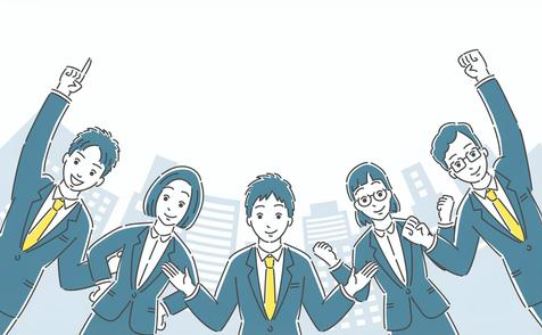What are Japanese-style employment practices?
CONTENTS
- Lifetime Employment: Japanese Style Management Systems Are Still Alive
- Secret of the Miracle
- What is Shushin Koyo? Lifetime Commitment Is Maintained
- Businesses May Be Liquidated, But Not People
- A Business Is a Community of Employees
- Employee-Centric Management is a Powerful Weapon
- Lifetime Commitment Is a Hard Road
- Japanese Are Always Pessimistic About the Future & Negative About the Present…
Lifetime Employment: Japanese Style Management Systems Are Still Alive
The collapse of Lehman Brothers in September 2008, like falling off a cliff, plunged the world into a seemingly bottomless pit of economic slowdown. In his first post-inaugural press conference President Obama said, “Japan was unable to mobilize quickly during the 1990s and thus experienced the so-called lost decade,” in a call for America not to repeat the same mistakes as Japan. Japanese people themselves still habitually refer to the “lost 2 decades” with a sense of self-admonition.
But there is someone who objects to this characterization, namely James Abegglen. His 1958 work “The Japanese Factory” revealed why Japanese-style management was so powerful, and fifty years later he presented the world with what might be called its sequel, “21st Century Japanese Management.” Therein is depicted the dynamic onrush of Japanese business and the Japanese economy over the last 50 years with an abundance of data and case studies.
Abegglen points out, “The term ‘lost decade’ is often used carelessly, and is absolutely ridiculous. These 20 years were not in fact lost for Japan, but were quite vigorous and successful.” What reality does Abegglen see that allows him to call “the lost decade” a ridiculous characterization?
One area that achieved remarkable progress during the lost decade is the steel industry. For many years there were five major players in the steel industry, namely, Nippon Steel, NKK, Kawasaki Steel, Sumitomo Metal Mining and Kobe Steel, and consequently competition was cut-throat. It was believed that steel as an industry would eventually die out in leading industrialized nations. It is a matter of fact that the British steel industry had collapsed and some of America’s leading steel manufacturers were also going under. When the bubble economy started in the mid-1980s, each of Japan’s steel makers went full out with efforts to diversify, thinking they needed to find a way out by developing new areas of business. They tried electronics, communications, biotechnology, urban development, etc. But with the bursting of the economic bubble, most of these new ventures fell into difficulty and all five steel makers posted losses for 1993.
Now 20 years later, the steel industry has shown a remarkable transformation. 2008 production in Japan was 120 million tons, surpassing past records. And this was achieved with just two-thirds of the amount of personnel at past peaks. This means labor productivity has risen as much as 30%, an especially significant fact since it was achieved while taking steps to deal with global warming. Energy efficiency among them is also topnotch in the world.
Secret of the Miracle

Nippon Steal Nagoya Factory
Japan’s steel industry commendably overthrew the established wisdom holding that fully matured industries like steel would eventually decline in industrialized nations. How did this miracle come to pass?
First NKK and Kawasaki Steel merged their steel businesses to form JFE Steel, while Nippon Steel, Sumitomo, and Kobe all deepened ties. By consolidating business, they boosted efficiency dramatically in production, management, and research & development. They made major rearranging of their newer ventures and focused management resources on their core business. And as a result of massive expenditure on research & development, they were able to shift emphasis to higher added value products for the domestic electronics and car manufacturing industries.
Supply of high added value product to leading industries in Japan became the core business while the export ratio continued to fall, to just 30% now. The largest export destination is Korea, homeland of Posco Steel which is said to have the lowest production cost in the world. But Japanese business remains overwhelmingly competitive in high added value product.
What is Shushin Koyo? Lifetime Commitment Is Maintained

Shushinkoyo promotes teamwork.
On the other side of the revival of the steel industry is another miracle, and that is how such a revival was achieved without instituting major cutbacks in personnel. Obviously it was necessary to reduce personnel numbers in order to reorganize excessive business diversification and improve efficiency in the core business of steel manufacture, but the companies used detailed and targeted employment strategies over time such as narrowing new hiring, using attrition through retirement and assigning personnel out to affiliated companies. That did tend to extend the period of hard times in terms of operating performance, but the companies were able to withstand it.
Employee benefits were also kept at a high level. Nippon Steel has 14,000 family dormitories as well as single dormitory space for 5,000 people. It has a homeowner financing system and financial assistance for child education. And, long-term employees can get travel coupons and special days off. To have held onto these employee benefits even during the worst days after the economic bubble burst is deserving of special mention.
The term “shushin koyo” in Japanese (most often translated as lifetime employment) which was named “lifetime commitment” by Abegglen after his analysis of Japanese business employment practices, seems to have expanded. Now as we enter the 21st century, Japan’s mass media advertises that lifetime employment is dead, but that is not true. Compared to before the economic bubble burst, the average number of years of continuous service to a company has risen. In a wide-ranging survey done in July 2003 by Asahi Shimbun of Japan’s largest 100 companies, 88 companies responded that they would maintain their lifetime employment system.

Businesses May Be Liquidated, But Not People
When getting out of a new business that has proved unsuccessful financially, an American company for example would consider it fine to simply fire all of that division’s employees. The employees would probably put up a good fight, but if unsuccessful would have to start searching for a new job the very next day, tending to neglect the business withdrawal process. The customers would be the ones to suffer in this case, and would end up with a bad impression of the company. Employees in other divisions of the company would be constantly on edge, wondering if it was their turn next. Though chopping off poorly performing sections of a company can mean that sharp financial regains are achieved in a short period of time, on the psychological scale the unfavorable impact on company morale and customer approval lingers for a long time.
On the other hand, at most Japanese companies, even if divisions that are losing money are closed, the people that work at those divisions are either moved to other divisions within the company or, even if they are let go, in most cases taken care of by the company until they find other employment. When handled in this manner employee resistance to change is lower. They will work hard all the way up to the end on the process of closing the business and probably take a good deal of care to ensure that customers are not inconvenienced.
“The business may be liquidated but not the people”... Under such a policy that puts the emphasis on the employees, performance cannot be expected to recover quickly, but by valuing relationships with customers and employee morale, over the medium term it is possible to create a stronger business quality or corporate culture. Seen from the outside, the 90s may look like a “lost decade” since there was no clear-cut or rapid recovery, but most Japanese companies over those 20 years steadily made themselves stronger constitution-wise. The steel industry is just one example.
A Business Is a Community of Employees

Company as a Community
Whether expanding the scale of the business through merger or correcting over-diversification, after the economic bubble burst Japanese business pushed through steady reforms, always stubbornly sticking to employee-centric management, however, when it came to people. Abegglen says, “What distinguishes the Japanese system of management is the part that has to do with people. Japanese business culture is founded on this part.”
More than anything else, Japanese business is a social organization. The people that comprise the business are positioned at the center of the management system. The employees that work at the business are the nexus of the company’s stakeholders. That is because what comprises the community, that is the company, is its employees. Yet it is not just Japan that believes the company is a community of employees. Management scholar Peter Drucker points out that with the exception of the UK and the US, no advanced nation believes that a company exists for the sake of its shareholders. In most nations, a company exists for the sake of social harmony and employment.
Even in America, a Business Week magazine survey showed that of the top 500 companies 177 were family-owned. Compared to the other companies, these family-owned companies were clearly better in terms of profitability and longevity. According to Business Week’s analysis, this is because in family-owned businesses, command is taken by family leaders with strong esprit de corps, so that decision-making comes quickly and easily, allowing these businesses to take advantage of opportunities that ordinary companies let pass by. The corporate culture of many of these businesses is paternal or familial, so there is not a lot of employee turnover and management successors can be cultivated. In contrast to an outside CEO, a family member CEO knows that the family will be involved with the business into the future so that he or she is more likely to invest proactively in the business.
Employee-Centric Management is a Powerful Weapon
In terms of competing in advanced technology products or high added value products, an employee-centric policy can be a powerful weapon. In order to practice advanced product development, technical experts from a variety of fields must be gathered and be able to work closely together as a team. In a lifetime commitment type of organization, the company is able to spend a lot of time and money on nurturing and educating technical experts based on the condition that employees will work for the company for an extended period of time. And because they are working together for a long period of time, teamwork becomes easy.
In the plant as well, in order to learn how to use advanced manufacturing equipment workers must be constantly honing their skills and working on process improvement in order to eliminate mistakes and waste. The average number of improvement suggestions made per employee per year can be in excess of ten or twenty at many companies.
In the retail industry, proficiency and ingenuity in the shape of employees that seek to increase their product knowledge and refine their skills in buying and display are sought after. A lifetime commitment type of personnel system is a valid means of cultivating this type of employee. While there has recently been an increase in companies that try to cut labor costs by employing more non-regular employees such as haken temporary workers, part-timers, on the other hand is the increase in companies that decide it is better to convert non-regulars to full employee status, thereby increasing their desire to work hard, boosting productivity and business process quality. The fact that 88 out of 100 companies said they would maintain lifetime employment systems is probably because many companies recognize this point.
Lifetime Commitment Is a Hard Road
Lifetime employment system is still a norm in Japan
The sudden and dramatic depression occurring over the past several months has made the dismissal of temporary haken workers into a major social problem (known as haken giri). Sensationalistic reporting by the mass media certainly does not help matters, but it is probably true that such a cold-hearted manner of dismissing workers arouses feelings of resistance considering the sensibility of the Japanese people who are used to a lifetime commitment system. If the company is one that is trying to beat out the global competition in a higher added value product, then the best course is to avoid the easy way, namely cutting labor costs by using haken temporary workers, and instead use lifetime employment of regular, fully-fledged employees to address personnel training and technical development. The simplest work can be automated or moved to low wage countries.
As for the employee, he or she needs to be aware that there can be hardships under the lifetime commitment system, such as being transferred overseas without one’s family, or being passed over for a favored type of job. There is no room for self-indulgence as might befit a haken worker. Living in the community, that is the company, means that sometimes you must make sacrifices for the sake of the whole. Lifetime commitment is in one sense a rigid arrangement from which there is no running away, neither for the company nor for the employee. Most Japanese companies in this manner cut off all escape, and then consistently walked the path of reform under the best practices of employee training and technical development, leaving behind excellent business performance as a result.
Japanese Are Always Pessimistic About the Future & Negative About the Present…
Abegglen says based on this analysis, “Japan’s record over the past 50 years and its prospects for the next one hundred, are worthy of praise from overseas and pride at home.” Certainly the management style of Japanese business that is backed by employee-centricism and lifetime commitment type labor practices can become a benchmark for the companies of the world to get out of the current economic slump. Abegglen points out that Japan’s biggest problem regardless of this is that Japanese people themselves are not aware of it. “The most serious of the problems confronting Japan in the 21st century may be this lack of confidence. Japanese always see the future with pessimism and the present with negativity, and although these views are clearly groundless, the fact is that these views are firmly rooted.”
The world has called a halt to the ways of financial capitalism, and is searching for a new, sustainable paradigm. What comes next may be a socio-economic system that is kind to both the Earth and her people, and that centers itself on the ordinary citizen. If that’s the case, then the strengths of the Japanese people can be even better put to the test.
- Categories
- Work in Japan: Japan Biz Cultural Words and 未分類


